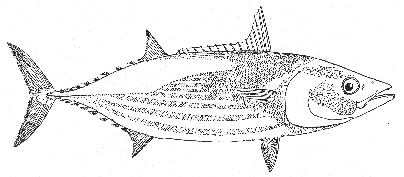Striped bonito Euthynnus pelamis (Linnaeus) 1758
OCEANIC BONITO
[Jordan and Evermann, 1896-1900, p. 868, Gymnosarda pelamis.]
Description—
The various fishes commonly called bonitos, albacores, and tuna, are fusiform in shape like all their family, tapering to a pointed nose and to an extremely slender caudal peduncle. But they are much stouter-bodied than mackerel or chub mackerel, and their second dorsal fin originates close to the rear end of the first dorsal, instead of being separated from the latter by a long interspace. The present species is about one-fourth as deep as it is long; its caudal peduncle has one prominent median longitudinal keel on either side, with a smaller keel above it, and another below at the base of the tail. The very deeply concave contour of its first dorsal fin (fig. 178) is enough to separate it at a glance from the common bonito (fig. 180), or from a young tuna (fig. 181), and from the Spanish and king mackerels (figs. 182, 183). The fact that its sides have dark markings below the lateral line, but not above the latter, is the readiest field mark by which to distinguish it from its close relative the false albacore (p. 336), in which the reverse is true. Also, its anal fin originates [page 336] farther forward than in the false albacore; i. e., under the middle of the second dorsal fin, instead of under the first dorsal finlet.
Another distinctive character (shared, however, by the false albacore, p. 336) is that it has no body scales except along the lateral line, and covering a very prominent corselet on the forward and upper part of the trunk, which is outlined in the illustration (fig. 178). Its lateral line curves downward suddenly below the second dorsal which is not the case in its relative alleteratus (p. 336).
The first dorsal fin (about 15 spines) is not only much longer, relatively, than that of the mackerel, but its upper edge is abruptly concave behind the second spine, with the last 9 or 10 spines much shorter. The second dorsal is triangular, with concave rear edge; almost the whole of it stands in front of the anal; the anal is as large as the second dorsal and of about the same shape. There are about 8 little finlets behind the second dorsal, and about 7 finlets behind the anal. The pectorals are of moderate size, reaching back only about midway of the first dorsal. The tail fin is very short but broad and lunate in outline.
Color—
Deep steel blue above, with the lower part of the sides, the throat and the belly shining white. Each side is barred behind the corselet with 4 to 6 longitudinal blue or brown stripes, the upper ones terminating at their intersection with the lateral line, the lower 3 or 4 fading out as they near the caudal peduncle.[79]
Size—
This bonito grows to a length of about 30 inches.
General range—
Warmer parts of all the great oceans, the Atlantic, Pacific, and Indian.
Occurrence in the Gulf of Maine—
A specimen obtained at Provincetown in 1880 by J. Henry Blake is the only record for this oceanic fish in the Gulf, but it sometimes appears in numbers about Woods Hole, where 2,000 to 3,000 were taken in 1878, but where it did not show again until October 1905.
[79] The number of stripes is different in different geographic regions; American fish usually show only 4; 7 have been described for Japanese specimens; there usually are 4, and sometimes 5 or 6, on each side in the European bonito.
